 Library of Congress Cataloging-in-Publication Data Names: Bennett, Beverly Lynn, author. Title: Anti-inflammatory foods and recipes : using the power of plant foods to heal and prevent arthritis, cancer, diabetes, heart disease, and chronic pain / Beverly Lynn Bennett. Description: Summertown, Tennessee : Book Publishing Company, [2017] | Includes index. Identifiers: LCCN 2017007125 | ISBN 9781570673412 (pbk.) Subjects: LCSH: InflammationDiet therapy. | InflammationDiet therapyRecipes. Classification: LCC RB131 .B46 2017 | DDC 616/.0473dc23 LC record available at https://lccn.loc.gov/2017007125 Nutrition Breakdowns for Recipes: The nutrient values provided for the recipes in this book are estimates only, calculated from the individual ingredients used in each recipe based on the nutrition data found for those ingredients.
Library of Congress Cataloging-in-Publication Data Names: Bennett, Beverly Lynn, author. Title: Anti-inflammatory foods and recipes : using the power of plant foods to heal and prevent arthritis, cancer, diabetes, heart disease, and chronic pain / Beverly Lynn Bennett. Description: Summertown, Tennessee : Book Publishing Company, [2017] | Includes index. Identifiers: LCCN 2017007125 | ISBN 9781570673412 (pbk.) Subjects: LCSH: InflammationDiet therapy. | InflammationDiet therapyRecipes. Classification: LCC RB131 .B46 2017 | DDC 616/.0473dc23 LC record available at https://lccn.loc.gov/2017007125 Nutrition Breakdowns for Recipes: The nutrient values provided for the recipes in this book are estimates only, calculated from the individual ingredients used in each recipe based on the nutrition data found for those ingredients.
Optional items are not included. Nutrient content may vary based on methods of preparation, origin and freshness of ingredients, product brands, and other factors. 
| We chose to print this title on responsibly harvested paper stock certified by The Forest Stewardship Council, an independent auditor of responsible forestry practices. For more information, visit us.fsc.org. |  |
2017 Beverly Lynn Bennett All rights reserved. No portion of this book may be reproduced by any means whatsoever, except for brief quotations in reviews, without written permission from the publisher.
Cover and interior design: John Wincek Food styling and photography: Alan Roettinger Stock photography: 123 RF Printed in the United States of America Book Publishing Company PO Box 99 Summertown, TN 38483 888-260-8458 bookpubco.com Disclaimer: The information in this book is presented for educational purposes only. It isnt intended to be a substitute for the medical advice of a physician, dietitian, or other healthcare professional. ISBN: 978-1-57067-341-2 22 21 20 19 18 171 2 3 4 5 6 7 8 9
contents

anti-inflammatory
FOODS AND RECIPES
CHAPTER 1
defining inflammation
Inflammation is either the cause or consequence of nearly every injury, infection, and disease, and sometimes its both. In a nutshell, inflammation is the immune systems defense mechanism in action. Under normal circumstances, inflammation occurs in response to an injury or infection and then stops once the problem has resolved. This is called acute, or useful, inflammation, and its symptoms are unmistakable.
The root of the word inflammation derives from the Latin inflammare, which means to catch fire or to burst into flames. This term encompasses the four symptoms that arise when the body experiences inflammation: redness, heat, swelling, and pain. After an injurywhether its a sprained wrist, a stubbed toe, a pinched finger, or an insect biteall four symptoms will appear. Redness and heat indicate that blood is flowing to the location of the injury. Swelling occurs as plasma begins to fill the surrounding tissues. Pain is the telltale sign that something is amissa message the body is under attack and requires immediate attention.
These symptoms are often acute at first but gradually dissipate as the healing process progresses. Eventually the body returns to normal, and in most cases not even a scar remains. Acute systemic infections (those that occur throughout the body) often take longer to manifest, but they elicit the same response from the immune system. With infection from a flu virus, for example, there might initially be a vague feeling of discomfort, followed by a burning in the eye sockets or joints, chills, and finally a fever. These are signs the body is fighting off the infection. Some people take anti-inflammatory drugs, such as ibuprofen, to relieve the discomfort.
Others simply allow the fever to run its course and destroy the invading pathogen. Allergies also trigger an inflammatory response. For instance, when people are exposed to environmental substances or foods theyre allergic to, the immune system will launch an attack, causing symptoms such as a runny nose, itchy skin, or swollen joints. Usually these symptoms subside naturally once the offending allergen is removed. However, hypersensitive allergic reactions, known as anaphylaxis, can be life threatening and require immediate medical intervention. Of course, more serious illnesses require more robust therapies.
But in all cases, inflammation is the bodys natural response to an invasive attack, and it usually abates once the healing is complete. Although the expression of acute inflammation can be unpleasant, its evidence of a healthy immune system.
WHAT HAPPENS DURING INFLAMMATION
W hen the body needs to respond to an injury, it mobilizes an army of specialized cells and chemicals to fight invading organisms and toxins. The specialized cells prepare pathways for fighter cells to attack and engulf the unwelcome invaders. Next, another group of cells signals the body that the fighter cells have been successful, which stops the production of the preparatory and fighter cells and triggers the appearance of cleanup and repair cells to clear the battlefield of debris and mend any damage. Simply put, there are two stages to the inflammatory response: pro-inflammatory and anti-inflammatory.
Each participating cell in the pro-inflammatory stage builds on the work of the previous cells and makes the immune reaction stronger. During the pro-inflammatory period, symptoms such as pain, itching, redness, heat, or swelling arise. The anti-inflammatory process puts out the fire, reversing the pro-inflammatory reaction and returning the body to normal. A number of substances that either cause or block inflammation are made from essential fatty acids, which are fats the body cannot produce on its own. These fatty acids must be obtained from foods or supplements. There are two families of essential fats: omega-3s and omega-6s.
Omega-6 fatty acids tend to increase inflammation; omega-3 fatty acids help to curtail it. Its important to remember that in a more complex depiction of the process of inflammation, some of these substances have multiple roles, including promoting the battle phase of inflammation and subsequently shutting it down when its no longer necessary. The most common roles are explained in the descriptions that follow.
The Preparatory Substances
A number of different substances work together to alert the body theres been an injury. Other substances prepare the area around the injury to make it easier for healing substances to fight harmful invading microbes.
Histamine. White blood cells near the injury site release a substance called histamine, which increases the permeability of blood vessels around a wound.
This signals fighter cells and other substances that regulate the immune response to come to the site of the injury. They gain easier access to the site because histamine makes the surrounding blood vessels more porous. Histamine also instigates swelling and redness around the site of the injury. Its effects are particularly noticeable during an allergic reaction, when symptoms might include a runny nose, itchy eyes, or a rash.
Next page




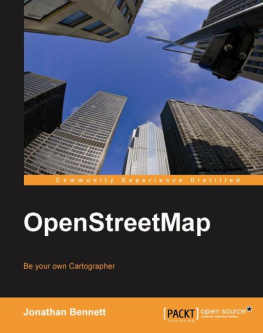
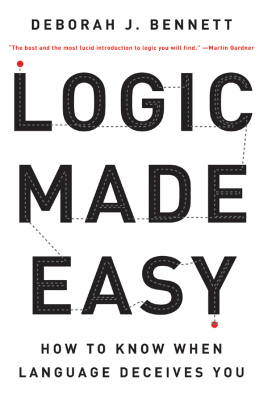
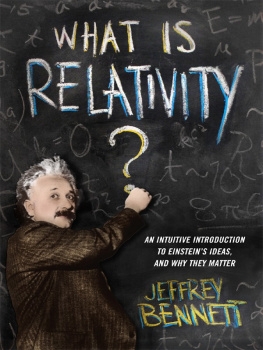
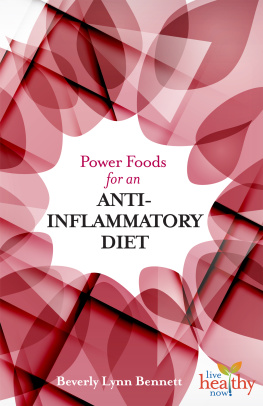
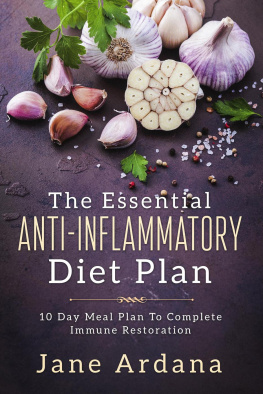
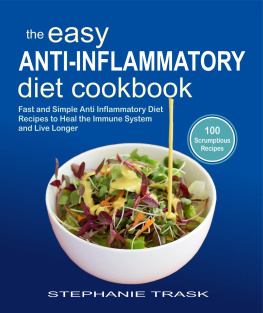

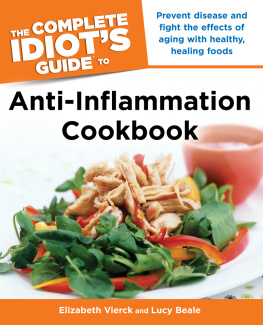
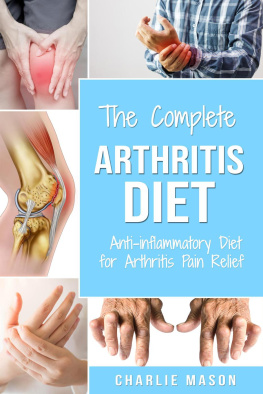
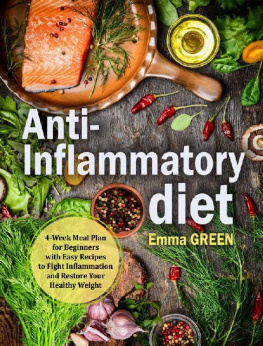
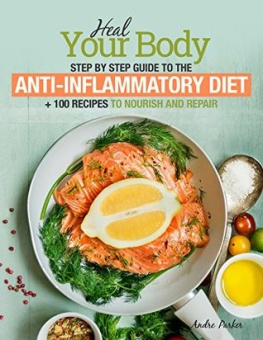
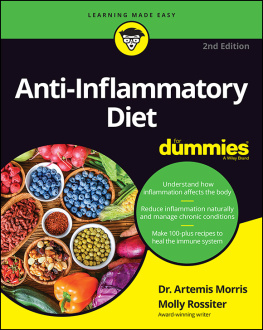

 Library of Congress Cataloging-in-Publication Data Names: Bennett, Beverly Lynn, author. Title: Anti-inflammatory foods and recipes : using the power of plant foods to heal and prevent arthritis, cancer, diabetes, heart disease, and chronic pain / Beverly Lynn Bennett. Description: Summertown, Tennessee : Book Publishing Company, [2017] | Includes index. Identifiers: LCCN 2017007125 | ISBN 9781570673412 (pbk.) Subjects: LCSH: InflammationDiet therapy. | InflammationDiet therapyRecipes. Classification: LCC RB131 .B46 2017 | DDC 616/.0473dc23 LC record available at https://lccn.loc.gov/2017007125 Nutrition Breakdowns for Recipes: The nutrient values provided for the recipes in this book are estimates only, calculated from the individual ingredients used in each recipe based on the nutrition data found for those ingredients.
Library of Congress Cataloging-in-Publication Data Names: Bennett, Beverly Lynn, author. Title: Anti-inflammatory foods and recipes : using the power of plant foods to heal and prevent arthritis, cancer, diabetes, heart disease, and chronic pain / Beverly Lynn Bennett. Description: Summertown, Tennessee : Book Publishing Company, [2017] | Includes index. Identifiers: LCCN 2017007125 | ISBN 9781570673412 (pbk.) Subjects: LCSH: InflammationDiet therapy. | InflammationDiet therapyRecipes. Classification: LCC RB131 .B46 2017 | DDC 616/.0473dc23 LC record available at https://lccn.loc.gov/2017007125 Nutrition Breakdowns for Recipes: The nutrient values provided for the recipes in this book are estimates only, calculated from the individual ingredients used in each recipe based on the nutrition data found for those ingredients.

 anti-inflammatory FOODS AND RECIPES
anti-inflammatory FOODS AND RECIPES